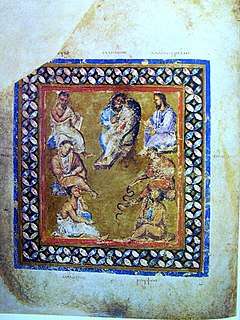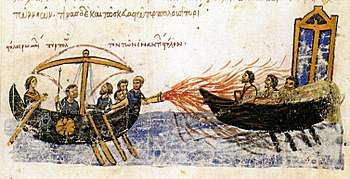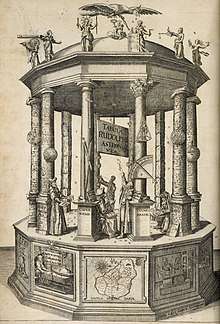Byzantine science
Byzantine science played an important role in the transmission of classical knowledge to the Islamic world and to Renaissance Italy, and also in the transmission of Islamic science to Renaissance Italy.[1] Its rich historiographical tradition preserved ancient knowledge upon which splendid art, architecture, literature and technological achievements were built.

Byzantines stood behind several technological advancements.
Classical and ecclesiastical studies
Byzantine science was essentially classical science.[2] Therefore, Byzantine science was in every period closely connected with ancient-pagan philosophy, and metaphysics. Despite some opposition to pagan learning, many of the most distinguished classical scholars held high office in the Church.[3] The writings of antiquity never ceased to be cultivated in the Byzantine Empire due to the impetus given to classical studies by the Academy of Athens in the 4th and 5th centuries, the vigor of the philosophical academy of Alexandria, and to the services of the University of Constantinople, which concerned itself entirely with secular subjects, to the exclusion of theology,[4] which was taught in the Patriarchical Academy. Even the latter offered instruction in the ancient classics, and included literary, philosophical, and scientific texts in its curriculum. The monastic schools concentrated upon the Bible, theology, and liturgy. Therefore, the monastic scriptoria expended most of their efforts upon the transcription of ecclesiastical manuscripts, while ancient-pagan literature was transcribed, summarized, excerpted, and annotated by laymen or clergy like Photios, Arethas of Caesarea, Eustathius of Thessalonica, and Basilius Bessarion.[5]
Mathematics
Byzantine scientists preserved and continued the legacy of the great Ancient Greek mathematicians and put mathematics in practice. In early Byzantium (5th to 7th century) the architects and mathematicians Isidore of Miletus and Anthemius of Tralles used complex mathematical formulas to construct the great Hagia Sophia church, a technological breakthrough for its time and for centuries afterwards due to its striking geometry, bold design and height. In middle Byzantium (8th to 12th century) mathematicians like Michael Psellos considered mathematics as a way to interpret the world.
Physics
John Philoponus, also known as John the Grammarian, was an Alexandrian philologist, Aristotelian commentator and Christian theologian, and author of philosophical treatises and theological works. He was the first who criticized Aristotle and attacked Aristotle’s theory of the free fall. His criticism of Aristotelian physics was an inspiration for Galileo Galilei many centuries later; Galileo cited Philoponus substantially in his works, and followed him in refuting Aristotelian physics.[6]
The theory of impetus was also invented in the Byzantine Empire.
Ship mill is an invention made by the Byzantines, and was constructed in order to mill grains by using the energy of the stream of water. The technology eventually spread to the rest of Europe and was in use until ca. 1800.[7][8]
Medicine
Medicine was one of the sciences in which the Byzantines improved on their Greco-Roman predecessors, starting from Galen. As a result, Byzantine medicine had an influence on Islamic medicine as well as the medicine of the Renaissance.[9]
The concept of hospital as institution to offer medical care and possibility of a cure for the patients due to the ideals of Christian charity, rather than just merely a place to die, appeared in Byzantine Empire.[10]
The first known example of separating conjoined twins happened in the Byzantine Empire in the 10th century when a pair of conjoined twins from Armenia came eventually to Constantinople. Many years later one of them died, so the surgeons in Constantinople decided to remove the body of the dead one. The result was partly successful as the surviving twin lived in three days before dying. But the fact that the second person survived for few days after separating it, was so impressive that it was mentioned a century and half years later again by historians. The next case of separating conjoined twins will be recorded first about 700 years later in the year 1689 in Germany.[11][12]
Incendiary weapons

Greek fire was an incendiary weapon used by the Byzantine Empire. The Byzantines typically used it in naval battles to great effect as it could continue burning even on water. It provided a technological advantage, and was responsible for many key Byzantine military victories, most notably the salvation of Constantinople from two Arab sieges, thus securing the Empire's survival. Greek fire proper however was invented in c. 672, and is ascribed by the chronicler Theophanes to Kallinikos, an architect from Heliopolis in the former province of Phoenice, by then overrun by the Muslim conquests.[13] It has been argued that no single person invented the Greek fire, but that it was rather “invented by the chemists in Constantinople who had inherited the discoveries of the Alexandrian chemical school...”.[14]
The grenade first appeared in the Byzantine Empire, where rudimentary incendiary grenades made of ceramic jars holding glass or nails were made and used on battlefields.[15][16][17]
Byzantine and Islamic science
During the Middle Ages, there was frequently an exchange of works between Byzantine and Islamic science. The Byzantine Empire initially provided the medieval Islamic world with Ancient and early Medieval Greek texts on astronomy, mathematics and philosophy for translation into Arabic as the Byzantine Empire was the leading center of scientific scholarship in the region at the beginning of the Middle Ages. Later as the Caliphate and other medieval Islamic cultures became the leading centers of scientific knowledge, Byzantine scientists such as Gregory Choniades, who had visited the famous Maragheh observatory, translated books on Islamic astronomy, mathematics and science into Medieval Greek, including for example the works of Ja'far ibn Muhammad Abu Ma'shar al-Balkhi,[18] Ibn Yunus, Al-Khazini (who was of Byzantine Greek descent but raised in a Persian culture),[19] Muhammad ibn Mūsā al-Khwārizmī[20] and Nasīr al-Dīn al-Tūsī (such as the Zij-i Ilkhani and other Zij treatises) among others.[21]
There were also some Byzantine scientists who used Arabic transliterations to describe certain scientific concepts instead of the equivalent Ancient Greek terms (such as the use of the Arabic talei instead of the Ancient Greek horoscopus). Byzantine science thus played an important role in not only transmitting ancient Greek knowledge to Western Europe and the Islamic world, but in also transmitting Arabic knowledge to Western Europe. Some historians suspect that Copernicus or another European author had access to an Arabic astronomical text, resulting in the transmission of the Tusi-couple, an astronomical model developed by Nasir al-Din al-Tusi that later appeared in the work of Nicolaus Copernicus.[1][22] Byzantine scientists also became acquainted with Sassanid and Indian astronomy through citations in some Arabic works.[19]
Humanism and Renaissance
| Byzantine culture |
|---|
 |
During the 12th century the Byzantines produced their model of early humanism as a renaissance of interest in classical authors, however, during the centuries before, (9-12) Humanism and wanting for classical learning was prominent during the Macedonian Renaissance, and continued into what we see now as the 12th century Renaissance under the Komnenoi. In Eustathius of Thessalonica Byzantine humanism found its most characteristic expression.[23] During the 13th and 14th centuries, a period of intense creative activity, Byzantine humanism approached its zenith, and manifested a striking analogy to the contemporaneous Italian humanism. Byzantine humanism believed in the vitality of classical civilization, and of its sciences, and its proponents occupied themselves with scientific sciences.[24]
Despite the political, and military decline of these last two centuries, the Empire saw a flourishing of science and literature, often described as the "Palaeologean" or "Last Byzantine Renaissance".[25] Some of this era's most eminent representatives are: Maximus Planudes, Manuel Moschopulus, Demetrius Triclinius and Thomas Magister. The Academy at Trebizond, highly influenced by Persian sciences, became a renowned center for the study of astronomy, and other mathematical sciences, and medicine attracted the interest of almost all scholars.[24] In the final century of the Empire Byzantine grammarians were those principally responsible for carrying in person, and in writing ancient Greek grammatical, and literary studies to early Renaissance Italy, and among them Manuel Chrysoloras was involved over the never achieved union of the Churches.[25]
See also
- Byzantine scholars in Renaissance
- List of Byzantine scholars
- Science in the Middle Ages
- Islamic science
- John Philoponus
References
- George Saliba (2006-04-27). "Islamic Science and the Making of Renaissance Europe". Retrieved 2008-03-01.
- "Byzantine Medicine - Vienna Dioscurides". Antiqua Medicina. University of Virginia. Archived from the original on 2012-07-19. Retrieved 2007-05-27.
- Some noteworthy exceptions to this tolerance include the closing of the Platonic Academy in 529; the obscurantism of Cosmas Indicopleustes; and the condemnations of Ioannis Italos and Georgios Plethon for their devotion to ancient philosophy.
- The faculty was composed exclusively of philosophers, scientists, rhetoricians, and philologists (Tatakes, Vasileios N.; Moutafakis, Nicholas J. (2003). Byzantine Philosophy. Hackett Publishing. p. 189. ISBN 0-87220-563-0.)
- Anastos, Milton V. (1962). "The History of Byzantine Science. Report on the Dumbarton Oaks Symposium of 1961". Dumbarton Oaks Papers. Dumbarton Oaks, Trustees for Harvard University. 16: 409–411. doi:10.2307/1291170. JSTOR 1291170.CS1 maint: ref=harv (link)
- "John Philoponus". Stanford Encyclopedia of Philosophy. 8 June 2007. Retrieved 14 December 2017.
- Wikander, Orjan. 2000. "Handbook of Ancient Water Technology". Brill. Page 383-384.
- "Boat mills: water powered, floating factories". LOW-TECH MAGAZINE.
- Temkin, Owsei (1962). "Byzantine Medicine: Tradition and Empiricism". Dumbarton Oaks Papers. 16: 97–115. JSTOR 1291159.
- Lindberg, David. (1992) The Beginnings of Western Science. University of Chicago Press. Page 349.
- "The Case of Conjoined Twins in 10th Century Byzantium - Medievalists.net". 4 January 2014.
- Montandon, Denys (December 2015). "THE UNSPEAKABLE HISTORY OF THORACOPAGUS TWINS' SEPARATION" (PDF). denysmontandon.com.
- Pryor, John H.; Jeffries, Elizabeth M. (2006). The Age of dromon: The Byzantine Navy, ca. 500-1024. The Medieval Mediterranean: Peoples, Economies and Cultures, 400-1500. vol. 62. Brill. pp. 607–609. ISBN 90-04-15197-4.
- Partington, J. R. (1999). "A History of Greek Fire and Gunpowder". The Johns Hopkins University Press. page 13
- Tucker, Spencer C. 2011. “The Encyclopedia of the Vietnam War: A Political, Social, and Military History”. ABC-CLIO. Page 450.
- "Greek Fire Grenades". ancient.eu.
- "Greek Fire". ancient.eu.
- "Introduction to Astronomy, Containing the Eight Divided Books of Abu Ma'shar Abalachus". World Digital Library. 1506. Retrieved 2013-07-16.
- Pingree, David (1964). "Gregory Chioniades and Palaeologan Astronomy". Dumbarton Oaks Papers. 18: 135–60.
- King, David A. (March 1991). "Reviews: The Astronomical Works of Gregory Chioniades, Volume I: The Zij al- Ala'i by Gregory Chioniades, David Pingree; An Eleventh-Century Manual of Arabo-Byzantine Astronomy by Alexander Jones". Isis. 82 (1): 116–8. doi:10.1086/355661.CS1 maint: ref=harv (link)
- Joseph Leichter (June 27, 2009). "The Zij as-Sanjari of Gregory Chioniades". Internet Archive. Retrieved 2009-10-02.
- E. S. Kennedy, "Late Medieval Planetary Theory," p. 377.
- Tatakes-Moutafakis, Byzantine Philosophy, 110
- Tatakes-Moutafakis, Byzantine Philosophy, 189
- Robins, Robert Henry (1993). "Chapter I". The Byzantine Grammarians: Their Place in History. Walter de Gruyter. p. 8. ISBN 3-11-013574-4.
Sources
- Lazaris, Stavros, ed. (2020). A Companion to Byzantine Science. Brill. ISBN 978-90-0441460-0.CS1 maint: ref=harv (link)
